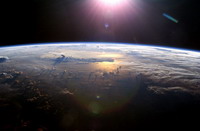Poles have different responses to global warming
The Earth's climate changes in response to external forcing, including variations in its orbit around the Sun, changes in solar luminosity, volcanic eruptions, and atmospheric greenhouse gas concentrations. But what is of more interest - to date the poles have responded differently, with little change in the South.

In the North global warming and natural variability of climate were reinforcing one another, reducing the amount of sea ice in the Arctic.
In recent years the extent of the sea ice has declined, and there is some evidence suggesting Arctic water may be ice-free in summer. Some estimates suggest an ice-free summer Arctic by 2040, or 2100, while a more recent study accompanied by unexpected increased melting in summer 2007 estimates as soon as 2013. However according to the Norwegian International Polar Year Secretariat the arctic polar ice cap would be completely gone by summer 2008.
On the other hand, most of the Antarctic's icy mass has so far proven largely impervious to climate change. However, Antarctica's periphery has been noticeably affected by global warming, particularly on the Antarctic Peninsula and in Pine Island Bay which together are contributing to a rise in sea levels.
The relatively stable condition can be explained by the ozone hole which was detected by scientists in 1973 and continues to grow to this day. It masks conditions there, keeping temperatures low in most of the continent other than the peninsula reaching toward South America. But the ozone hole recovers in coming years, and global warming will finally affect the South Pole also.
According to NASA, the most significant Antarctic melting in the past 30 years occurred in 2005, when a mass of ice comparable in size to California briefly melted and refroze; this may have resulted from temperatures rising to as high as 5 °C (41 °F).
A bridge made of ice based on the Leonardo da Vinci draft plans for a bridge over the Golden Horn in Istanbul was built in Antarctica in 2007. This project was a plea to the world to stop the causes of global warming in the hope that the " Leonardo Bridge " in Antarctica remains standing forever. (A similar ice bridge had been constructed in the garden of United Nations on 15 December 2007 for the purpose of demonstrating global warming. That bridge melted fully on Christmas Day 2007).
On February 28 through March 8, 2008, about 570 square kilometers of ice from the Wilkins Ice Shelf in Western Antarctica suddenly collapsed, putting the remaining 15,000 square kilometers of the ice shelf at risk. The ice is being held back by a "thread" of ice about 6 km wide.
Photo: www.wikipedia.org
Subscribe to Pravda.Ru Telegram channel, Facebook, RSS!


